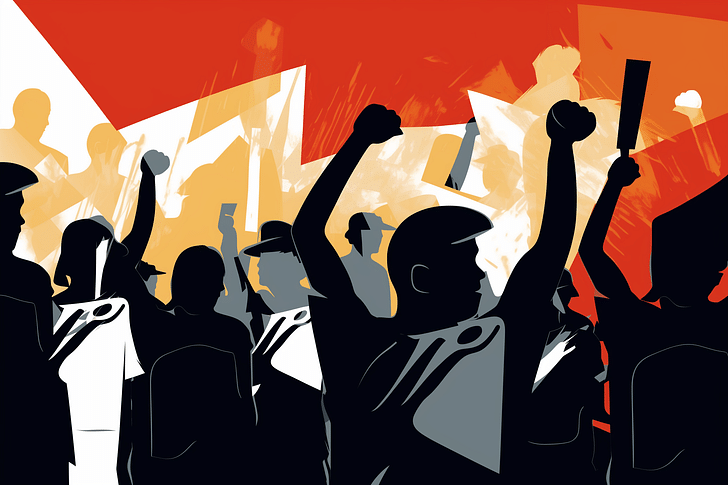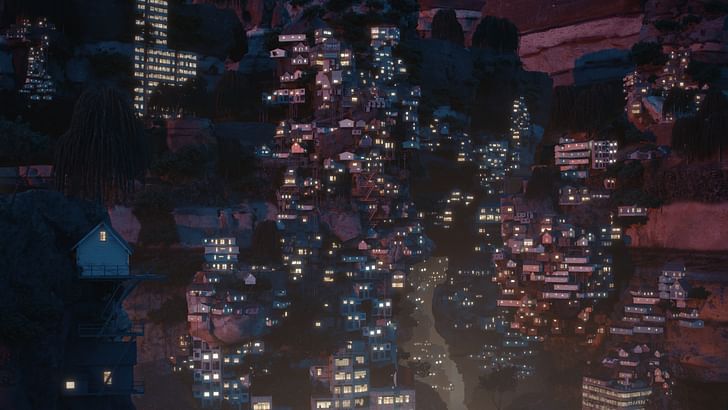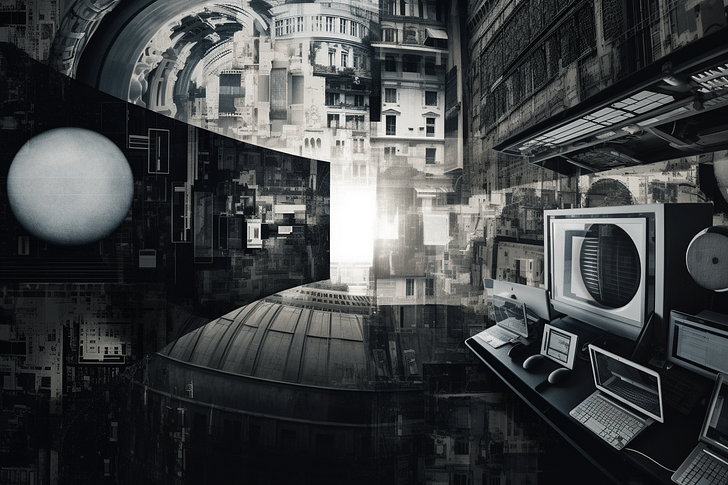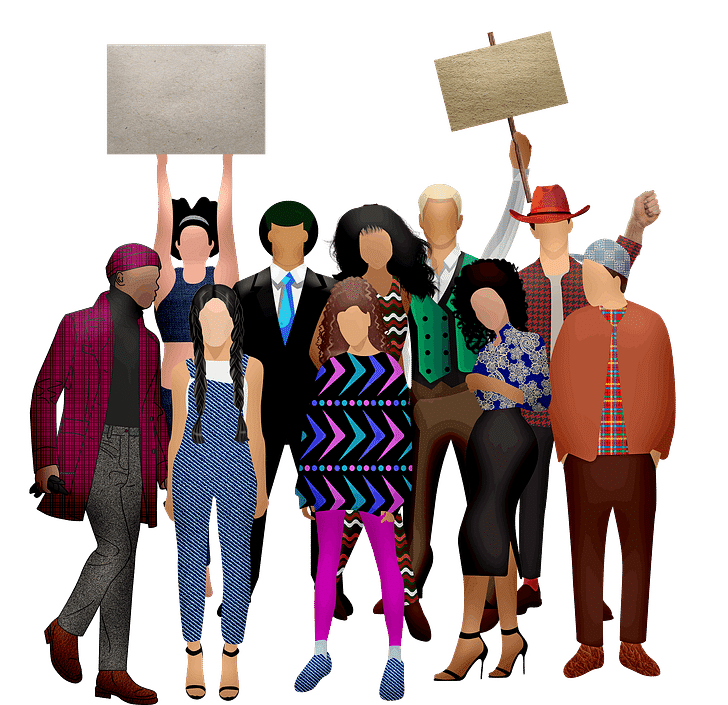

The proliferation of generative AI tools such as Midjourney and ChatGPT has undermined long-held assumptions that artificial intelligence would not threaten creative disciplines. In an effort to balance the opportunities and limits of artificial intelligence in the architecture studio, we ask what lessons architects can take from recent successful labor actions by screenwriters and actors in Hollywood's entertainment industry.
This article is part of the Archinect In-Depth: Artificial Intelligence series.
On September 26th, 2023, one of the longest labor strikes in Hollywood history came to a close. The Writers Guild of America (WGA), a union representing over 11,000 writers and creators of content from motion pictures to news, entered an agreement with the Alliance of Motion Picture and Television Producers that introduced guardrails on how artificial intelligence could be deployed in film, television, and streaming projects. The strike, which had been in place since May 2nd, 2023, was supported by complementary industrial action by actors under the Screen Actors Guild (SAG), who voiced similar concerns over their place in the industry in the age of generative AI. Estimates place the cost of the strikes on California’s economy at $6 billion.
“The whole entertainment industry is shut down right now because people are striking in fear of their jobs, and in fear that AI is going to be deployed to displace all of the creators in the industry,” architect and director Liam Young told me at the height of the strike action. “It’s a seminal moment. It is like being on the Luddite picket line about to storm a textile mill. This is the first real-scale union action against AI. It is an undeniable moment. We are at the peak of an AI hype cycle.”
It just so happens that the most PR-friendly applications of AI right now are to make images and write stories. — Liam Young
Two aspects of the Hollywood strikes are notable for architects. The first was addressed succinctly by Young in our conversation, who noted the irony of a creative discipline such as writing and storytelling becoming an early battleground against automation by generative AI. While almost 350 strikes took place across the United States in 2023, the most in two decades, a majority were directed at service providers or retail employers in protest over unfair compensation and unsafe workplace conditions. Artificial intelligence and automation, while dominating the discourse in Hollywood, was comparatively less of a motivating issue for high-profile strikes at Starbucks and Amazon, with the notable exception of an October 2023 intervention by Amazon Labor Union president Chris Smalls, which we will return to later in this article.
“The great irony is that we’ve historically been busy designing AI to perform mundane activities and allow us to engage in more creative jobs,” Young told me back in July 2023. “AI was supposed to do the boring stuff we didn’t want to do, leaving us with time to compose symphonies and write novels. It just so happens that the most PR-friendly applications of AI right now are to make images and write stories.”

The message is clear: Creativity is not an impenetrable safeguard against automation. Before the seismic arrival of generative AI apps such as Midjourney and ChatGPT in the 2020s, conventional wisdom held that creative disciplines such as architecture would be the last to fall in the line of occupations threatened by automation. Such sentiments were captured in an analysis by Oxford University in 2013, which placed the probability of architects being automated by computers at under 2%, just outside the top 10% of roles safe from automation. Other creative disciplines scored similarly safely, including 'Multimedia Artists and Animators' (1.5% probability of automation), 'Writers and Authors' (3.8% probability of automation), and 'Musicians and Singers' (7.4% probability of automation). Ironically, in the context of the recent Hollywood strikes, ‘Actors’ were offered a more precarious outlook in the Oxford study with a 37% risk of automation — ten times that of their screenwriting collaborators.
“Even if we could identify and encode our creative values, to enable the computer to inform and monitor its own activities accordingly, there would still be disagreement about whether the computer appeared to be creative,” the Oxford researchers argued. “In the absence of engineering solutions to overcome this problem, it seems unlikely that occupations requiring a high degree of creative intelligence will be automated in the next decades.”
Today, with the origins and processes of human creativity unresolved, it is impossible for us to quantify and design such a creative process through computation.
One decade on from the Oxford study, the foundation of the authors’ thesis that ‘automation of creative roles is unlikely’ has not been demolished, though the advent of generative AI has left them eroded. One argument as to why confidence in the insulation of creativity may have been misplaced was the assumption that to produce a ‘creative’ output, artificial intelligence must itself be ‘creative’ in the human sense. This is a dangerous game to play, considering that even we humans cannot agree on what creativity is or how to measure it. Unsure of how to define creativity, we lump it into the black hole of the subconscious, exemplified by Leonard Cohen’s description of David, the “baffled king composing,” suspended in disbelief by his own ability to create his “secret chord” that “pleased the Lord.”
Today, with the origins and processes of human creativity unresolved, it is impossible for us to quantify and design such a creative process through computation. However, generative tools such as Midjourney demonstrate how one does not need to mimic human creativity to produce a product that many consumers would classify as creative. Returning to Cohen’s scenario, there is merit in reflecting on the “secret chord” as a product in its own right. Would that same chord have “pleased the Lord” had it come not from David but from algorithms trained to produce melodically resolved tunes from millions of acclaimed musical compositions? How safe are the creative disciplines in a world that places value on novel or unexpected outputs, such as a visually provocative drawing, rather than whether or not the drawing was the result of a human-led creative process or a machine-led process? Does it matter that the machine used a method that bears no resemblance to human creativity? As a consequence, does artificial intelligence necessarily have to mimic your existing job process to render you unemployed?

Regardless of whether the Oxford paper from 2013 holds true in decades to come, the unease at which creative disciplines in Hollywood have viewed generative artificial intelligence serves as a reminder to architects that creativity is not the economic shield it was once assumed to be. Those who say with confidence that artificial intelligence will not play a significant role in the evolution, or devolution, of the architectural profession in the coming years and decades must find alternative routes to support their hypothesis.
The unease at which creative disciplines in Hollywood have viewed generative artificial intelligence serves as a reminder to architects that creativity is not the economic shield it was once assumed to be.
For Archinect’s part, 2023 saw our editorial undertake an extensive exploration of artificial intelligence’s relationship with the architectural profession, with dozens of voices either opining through research, or demonstrating through practice, that artificial intelligence will play a significant role in the future of the profession. The question of how the wider profession may adapt to this role, from education to licensure to business models, will be explored in a separate article. However, one adaption which we will discuss here, and which represents the second architecturally-relevant aspect of the recent Hollywood writers and actors strikes, is the impact of artificial intelligence on the labor movement.

It was not inevitable that fears over the impact of artificial intelligence on screenwriters and actors would result in collective industrial action. Faced with the prospects of AI-generated scripts or human-like digital avatars, workers could have reassured themselves, as many historically have, that machine creativity would never replace human creativity. The more pessimistic could have left the industry in search of more secure prospects or pitted themselves against their peers to climb the corporate ladder to a safer managerial role. Instead, workers actively exercised their collective bargaining power and defended their collective interests through the vehicle of labor unions, resulting in an agreement that MIT economist Simon Johnson heralded as “a model for the rest of the economy.”
“We didn’t get bogged down in the science-fiction version,” WGA negotiating committee member Adam Conover told The Guardian about the movement. “We didn’t protect ourselves against the technology, we protected ourselves against the humans on the other side of the table who are trying to screw us every day.”
In February 2024, less than six months after the WGA and SAG gained protections from their industries, the guarantee secured by striking workers may soon prove its worth, with OpenAI's showcasing the capabilities of its realistic text-to-video model Sora. Hollywood mogul Tyler Perry, who previously shut down his Tyler Perry Studios in support of the strikes, responded to OpenAI's promotion of Sora with “shock,” pausing plans for an $800 million expansion of his Atlanta studio complex.
“It can’t be one union fighting every contract every two or three years,” Perry told The Guardian. “I think that it has to be everybody, all involved in how do we protect the future of our industry because it is changing rapidly, right before our eyes.”
Hollywood screenwriters and actors were not the only workers to recognize the potential for labor unions to protect against the dangers posed by artificial intelligence to livelihoods. In an October 2023 interview with Fast Company, Amazon Labor Union president Chris Smalls warned of the fine line between artificial intelligence empowering or disempowering the worker, depending on how managers choose to deploy it. “If they can create a [system] where the machinery is helping reduce injuries, I support it,” Smalls told the outlet. “Replacing jobs? Not so much. I just hope to see that these jobs are unionized and they have some say in how the AI and technology is being incorporated.”

The confluence of artificial intelligence and labor unions comes at a seminal moment in the architectural profession. While Archinect called 2022 the year that “architecture’s labor movement roared back to life,” 2023 saw further efforts among workers in architectural practice and academia to organize in the name of more secure, equitable, and fairly compensated working conditions. At the forefront of such efforts in the United States is the International Association of Machinists and Aerospace Workers (IAMAW), an organization that first became familiar to many in the architecture profession when, in 2022, workers from SHoP under the collective name Architectural Workers United sought to affiliate with IAMAW in an ultimately unsuccessful union push. In a recent conversation with me on the intersection of artificial intelligence, labor, and architecture, IAMAW union organizer Andrew Daley struck a note of qualified optimism on the immediate potential for artificial intelligence in the architecture studio.
We look at [AI] as a way of reducing the amount of time things take, not so that we can replace it with more, but so that we can actually work less and reclaim some of that time that we've been giving away for so long. — Andrew Daley
“We’ve spoken before about architecture’s reliance on unpaid overtime, and the wasted time that stems from miscommunication and misalignment in architecture studios,” Daley told me before explaining the potential for artificial intelligence tools to more effectively collect and distribute pathways forward for projects. By reducing the volume of inefficient design and administration tasks undertaken in the office, Daley sees an opportunity for AI to combat the outsized prevalence of unpaid overtime in the architectural profession versus other economics sectors. “We look at it as a way of reducing the amount of time things take, not so that we can replace it with more, but so that we can actually work less and reclaim some of that time that we've been giving away for so long,” Daley added.

In a studio where artificial intelligence enables a more efficient pace of work, however, Daley warns that architects must not repeat the mistakes of the past, where improvements in efficiency through software, such as the jump from 2D drafting to 3D modeling, led to an explosion in the expected output from the profession without an increase in fees or perceived value.
“We held the belief that if we could draw more, then we could take more responsibility away from the contractor and we could control more of the process,” Daley continued. “That clearly hasn't happened and yet we are still just drawing more. Now that is the standard that everybody holds us to. All we have done is make contractors’ lives easier. We've taken their liability away from them and gotten nothing in return. When we introduce new technologies or workflows, we need to ask: What do we want out of this? What is our ultimate end game? How do we see this going forward?”
Ultimately, Daley echoes the sentiments of Chris Smalls in his conclusion that unionization presents an important avenue for architecture workers to exercise control over their role in an AI-infused workplace; an approach which appears to be vindicated by the agreement secured by WGA and SAG in Hollywood, whose guild model Daley cited as a case study in unionization benefits when speaking with me in 2022. While the WGA and SAG strikes took place against the backdrop of production companies openly signaling their interest in AI, such as Netflix recruiting a $900,000 position for an AI-focused product manager, Daley sees labor unions not only as a reactive step to encroaching threats but a proactive move for workers to secure their ability to shape their future careers in an increasingly unpredictable future.
When we introduce new technologies or workflows, we need to ask: What do we want out of this? What is our ultimate end game? How do we see this going forward? — Andrew Daley
“Sometimes, I will speak with individuals and groups who will tell me that they work in a great studio, and therefore do not need to organize,” Daley told me. “Part of my mission is to reset what we mean when we say ‘organize.’ You don’t need to organize only if you work in a studio with poor conditions. You need to organize so that you have the power to make changes in your workplace, whenever you need it, whatever that means, and however that applies.”
“If you don’t need to change a lot in your workplace right now, that is fine. But get what you have codified in writing in case that changes, whether that is in one year, five years, or ten years from now.”
Niall Patrick Walsh is an architect and journalist, living in Belfast, Ireland. He writes feature articles for Archinect and leads the Archinect In-Depth series. He is also a licensed architect in the UK and Ireland, having previously worked at BDP, one of the largest design + ...
4 Comments
Nothing against unions, but I'm not sure our profession is well suited to them, but if we try to beat AI with snazzy tech tools, we are done. What will protect us from AI is a deep and empathetic understanding of human nature and the subtleties of coordinating and prioritizing the specific requirements of each unique project. Unfortunately, that takes a long time to master and doesn't result in flashy graphics.
Agree with all that. Unions make a ton of sense in disciplines where there is significant profit being inequitably distributed - that's definitely not the case in Architecture as profit margins continue to fall through increased responsibility and competition from allied fields who are gaining fees while leaving risk and labor with the architects.
AI will likely never replace the Architects ability to synthesize and marshal lots of competing interests, experts and requirements. I just wish this received the attention it deserves both within the profession and in the academy...
What will protect us from AI is a deep and empathetic understanding of human nature and the subtleties of coordinating and prioritizing the specific requirements of each unique project.
ah yes, the good vibes have worked well so far.. who currently owns all the design software?
If the culture is geared to accept superficial and artificial and unsubstantial novels and building designs—and it is—and the system that produces them exploits that susceptibility, I don't see what hope we have. And it's already like that, without AI's help. Books are published by a handful of conglomerates, who have an eye only to what will sell most. Building designs are decided by corporate and civic powers, infatuated by trendy starchitects. Likely both will be enamored by AI creations, which will build on already thin ground, taking us further away from any cultural depth.
Block this user
Are you sure you want to block this user and hide all related comments throughout the site?
Archinect
This is your first comment on Archinect. Your comment will be visible once approved.